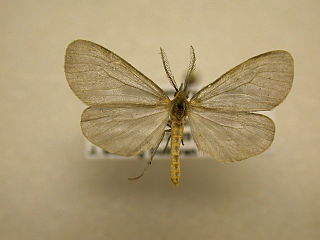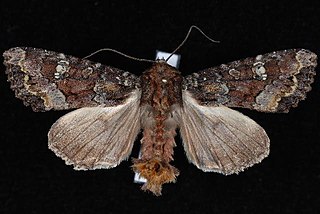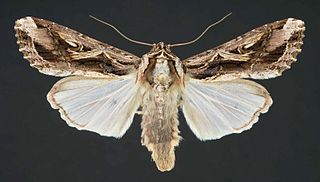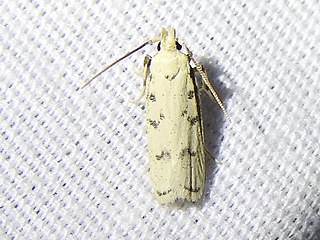Related Research Articles

The Mississippi River is the second-longest river and chief river of the second-largest drainage system on the North American continent, second only to the Hudson Bay drainage system. From its traditional source of Lake Itasca in northern Minnesota, it flows generally south for 2,340 miles (3,770 km) to the Mississippi River Delta in the Gulf of Mexico. With its many tributaries, the Mississippi's watershed drains all or parts of 32 U.S. states and two Canadian provinces between the Rocky and Appalachian mountains. The main stem is entirely within the United States; the total drainage basin is 1,151,000 sq mi (2,980,000 km2), of which only about one percent is in Canada. The Mississippi ranks as the fourteenth-largest river by discharge in the world. The river either borders or passes through the states of Minnesota, Wisconsin, Iowa, Illinois, Missouri, Kentucky, Tennessee, Arkansas, Mississippi, and Louisiana.
Delta commonly refers to:

The Glyphipterigidae are a family of small moths commonly known as sedge moths, as the larvae of many species feed on sedges and rushes. More than 500 species have been described in the family.

Mississippi is a state in the Southeastern region of the United States, bordered to the north by Tennessee; to the east by Alabama; to the south by the Gulf of Mexico; to the southwest by Louisiana; and to the northwest by Arkansas. Mississippi's western boundary is largely defined by the Mississippi River. Mississippi is the 32nd largest and 34th-most populous of the 50 U.S. states. Jackson is both the state's capital and largest city. Greater Jackson is the state's most populous metropolitan area, with an estimated population of 580,166 in 2018.

Pagara is a monotypic moth genus in the family Erebidae. Its only species, Pagara simplex, the mouse-colored lichen moth, is found in North America, where it has been recorded from Alabama, Arkansas, Florida, Georgia, Illinois, Indiana, Iowa, Kansas, Kentucky, Maryland, Mississippi, New Hampshire, North Carolina, Ohio, Oklahoma, South Carolina and Tennessee. Both the genus and species were described by Francis Walker in 1856.

Mathilde O'Callaghan "Tig" Notaro is an American stand-up comic, writer, radio contributor, and actress. She is known for her deadpan comedy. Her acclaimed album Live was nominated in 2014 for the Grammy Award for Best Comedy Album at the 56th Annual Grammy Awards. The special Tig Notaro: Boyish Girl Interrupted was nominated in 2016 at the 68th Primetime Emmy Awards for Outstanding Writing for a Variety Special. In 2017, the album Boyish Girl Interrupted was nominated for the Grammy Award for Best Comedy Album at the 59th Annual Grammy Awards.

Apamea amputatrix, the yellow-headed cutworm, is a moth of the family Noctuidae. It is found in most of North America, north to the Arctic.

Monopis laevigella, the skin moth, is a species of tineoid moth. It belongs to the fungus moth family (Tineidae), and therein to the nominate subfamily Tineinae. It is the type species of the genus Monopis and its junior objective synonym Hyalospila. As with the common clothes moth, earlier authors frequently misapplied the name Tinea vestianella to the present species.

Aethes smeathmanniana, or Smeathmann's aethes moth, is a moth of the family Tortricidae. It was described by Johan Christian Fabricius in 1781. It is found in most of Europe, Asia Minor and in North America, where it has been recorded from New Jersey and Newfoundland and Labrador.

The geranium plume moth is a moth of the family Pterophoridae. It is found in western Africa, Madagascar, India, Sri Lanka, Thailand, Japan, the New Hebrides and Central and South America, as well as Australia, where it has been recorded from Cape York to central New South Wales. It is also present in the United States, where it has been recorded from Florida, as well as Mississippi.

Geina tenuidactyla, the berry plume moth or Himmelman's plume moth, is a moth of the family Pterophoridae. The species was first described by Asa Fitch in 1854. It is found in North America, including Mississippi, Massachusetts, New York, Delaware, Maryland, West Virginia, Illinois, Ontario, Colorado, Nevada and California.

Stagmatophora wyattella, or Wyatt's stagmatophora moth, is a moth in the family Cosmopterigidae. The species was first described by William Barnes and August Busck in 1920. It is found in the US states of Maine, Ohio, Iowa, Kentucky, Michigan, Mississippi and Oklahoma.

Spodoptera dolichos, the dolichos armyworm moth or sweetpotato armyworm moth, is a moth of the family Noctuidae. The species was first described by Johan Christian Fabricius in 1794. It is found from the southern United States, south through Costa Rica to South America, as far south as Argentina. In the United States, it may occur as far north as Kentucky and Maryland.

Xyloryctidae is a family of moths contained within the superfamily Gelechioidea described by Edward Meyrick in 1890. Most genera are found in the Indo-Australian region. While many of these moths are tiny, some members of the family grow to a wingspan of up to 66 mm, making them giants among the micromoths.

David Adamski is an American entomologist working as a research associate at the Smithsonian Institution's National Museum of Natural History and a support scientist in the Systematic Entomology Laboratory (SEL), United States Department of Agriculture in Washington, D.C. He obtained a PhD degree from the Mississippi State University, Department of Entomology in 1987 after defending a dissertation, titled "The Morphology and evolution of North American Blastobasidae (Lepidoptera:Gelechioidea)". His research interests focus on alpha taxonomy, life histories and morphology of moths. Over the years, Adamski produced more than 80 scholarly publications, some in collaboration, shedding light on discernible groups of Lepidoptera including Gelechioidea, Tortricoidea, Pyralidoidea, and Noctuoidea. He studied divergent taxa within the Auchenorrhyncha and Sternorrhyncha, and Phytophagous Acari, as well as Gelechioidea and Blastobasidae. Adamski is a member of the Entomological Society of Washington.

Speranza is a genus of moths in the family Geometridae erected by John Curtis in 1828.

Diastictis argyralis, the white-spotted orange moth, is a moth in the family Crambidae. It was described by Jacob Hübner in 1818. It is found in North America, where it has been recorded from Colorado, Florida, Georgia, Indiana, Maine, Maryland, Mississippi, North Carolina, Ohio, Ontario, South Carolina, Tennessee, Texas and Virginia.
Agonopterix curvilineella, the curved-line agonopterix moth, is a moth in the family Depressariidae. It was described by William Beutenmüller in 1889. It is found in North America, where it has been recorded from Illinois, Indiana, Kentucky, Maine, Maryland, Massachusetts, Michigan, Minnesota, Mississippi, New Brunswick, New York, Ohio, Ontario, Quebec, Tennessee, West Virginia and Wisconsin.

Glyphidocera lactiflosella, the five-spotted glyphidocera moth, is a moth in the family Autostichidae. It was described by Vactor Tousey Chambers in 1878. It is found in North America, where it has been recorded from Alabama, Arkansas, Florida, Georgia, Louisiana, Maine, Mississippi, North Carolina, South Carolina, Tennessee and Texas.

A MONA number, or Hodges number after Ronald W. Hodges, is part of a numbering system for North American moths found north of Mexico in the Continental United States and Canada, as well as the island of Greenland. Introduced in 1983 by Hodges through the publication of Check List of the Lepidoptera of America North of Mexico, the system began an ongoing numeration process in order to compile a list of the over 12,000 moths of North America north of Mexico. The system numbers moths within the same family close together for identification purposes. For example, the species Epimartyria auricrinella begins the numbering system at 0001 while Epimartyria pardella is numbered 0002.
References
- ↑ Drymoana at Markku Savela's Lepidoptera and Some Other Life Forms
- ↑ Moth Photographers Group at Mississippi State University